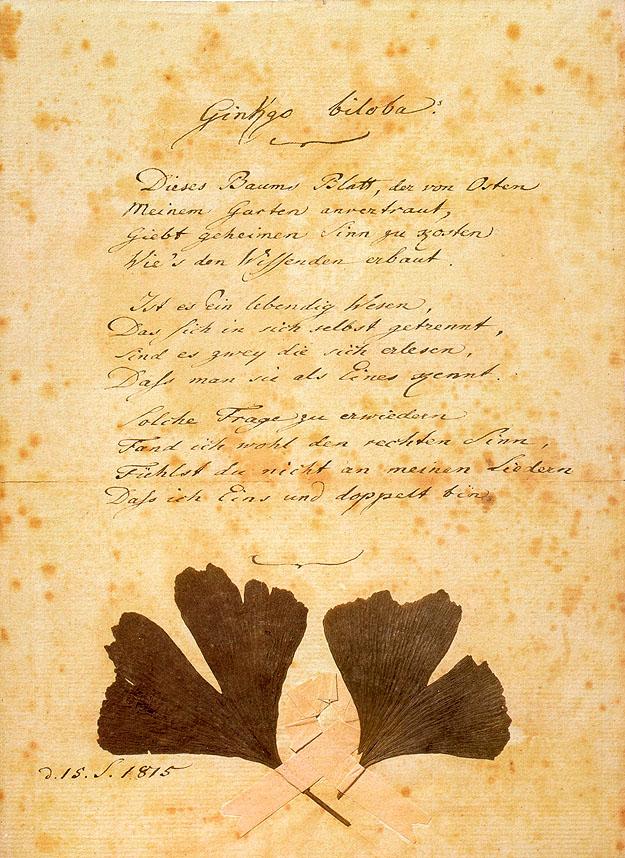Gingo biloba on:
[Wikipedia]
[Google]
[Amazon]
 "Gingo biloba" (later: "Ginkgo biloba") is a poem written by the German poet
"Gingo biloba" (later: "Ginkgo biloba") is a poem written by the German poet  The letter containing this poem with which Goethe included two Ginkgo leaves with two distinct lobes can be viewed in the Goethe Museum in
The letter containing this poem with which Goethe included two Ginkgo leaves with two distinct lobes can be viewed in the Goethe Museum in
 "Gingo biloba" (later: "Ginkgo biloba") is a poem written by the German poet
"Gingo biloba" (later: "Ginkgo biloba") is a poem written by the German poet Johann Wolfgang von Goethe
Johann Wolfgang von Goethe (28 August 1749 – 22 March 1832) was a German poet, playwright, novelist, scientist, statesman, theatre director, and critic. His works include plays, poetry, literature, and aesthetic criticism, as well as trea ...
. The poem was published in his work ''West–östlicher Divan
' (; ''West–Eastern Diwan'') is a diwan, or collection of lyrical poems, by the German poet Johann Wolfgang von Goethe. It was inspired by the Persian poet Hafez.
Composition
''West–Eastern Diwan'' was written between 1814 and 1819, the ...
'' (''West–Eastern Divan''), first published in 1819. Goethe used "Gingo" instead of "Ginkgo" in the first version to avoid the hard sound of the letter "k".
Goethe sent Marianne von Willemer (1784–1860), the wife of the Frankfurt banker Johann Jakob von Willemer (1760–1838), a ginkgo
''Ginkgo'' is a genus of non-flowering seed plants. The scientific name is also used as the English name. The order to which it belongs, Ginkgoales, first appeared in the Permian, 270 million years ago, and is now the only living genus within ...
leaf as a symbol of friendship and on September 15, 1815, he read his draft of the poem to her and friends. On September 23, 1815, he saw Marianne for the last time. Then he showed her the Ginkgo tree in the garden of Heidelberg Castle
Heidelberg Castle (german: Heidelberger Schloss) is a ruin in Germany and landmark of Heidelberg. The castle ruins are among the most important Renaissance structures north of the Alps.
The castle has only been partially rebuilt since its demoli ...
from which he took the two leaves pasted onto the poem. After that he wrote the poem and sent it to Marianne on September 27, 1815. Directly across from the Ginkgo tree stands the Goethe memorial tablet. The poem was published later in the "Book of Suleika" in ''West–östlicher Diwan''.
 The letter containing this poem with which Goethe included two Ginkgo leaves with two distinct lobes can be viewed in the Goethe Museum in
The letter containing this poem with which Goethe included two Ginkgo leaves with two distinct lobes can be viewed in the Goethe Museum in Düsseldorf
Düsseldorf ( , , ; often in English sources; Low Franconian and Ripuarian: ''Düsseldörp'' ; archaic nl, Dusseldorp ) is the capital city of North Rhine-Westphalia, the most populous state of Germany. It is the second-largest city in th ...
. The Ginkgo (planted in 1795) that Goethe led Marianne von Willemer to in September 1815 is no longer standing today. After 1928 the Ginkgo tree in the castle garden was labelled as "the same tree that inspired Goethe to create his fine poem". The tree was probably still standing in 1936. A is located in Weimar
Weimar is a city in the state of Thuringia, Germany. It is located in Central Germany between Erfurt in the west and Jena in the east, approximately southwest of Leipzig, north of Nuremberg and west of Dresden. Together with the neighbouri ...
.
References
{{Authority control Poetry by Johann Wolfgang von Goethe 1819 poems